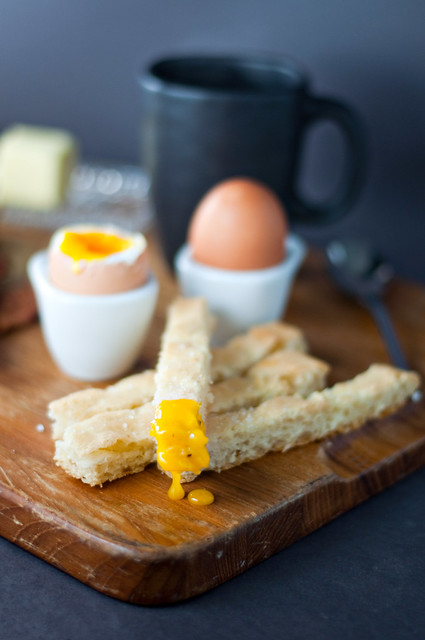
It is not a well-kept secret that I can't bake.
For some reason, from the start of every attempt, my confidence wavers, panic sets in, and my brain shifts firmly into the off position. In my mild defense, every time I feel I've followed the directions to the letter, somehow things do not turn out as they should.
Fortunately in my case, this isn't a devastating handicap—baked goods are not generally as high on my list as, say, cheese. Or pasta.
Though to be fair, I am not sure I could make either of those things, either.
Flour flummoxes me. I think I'm always using too much or too little, and I cannot measure it without simultaneously getting it all over my floor, countertop, and person.
I don't know exactly what is meant by "mix just until combined," but it's a veritable guarantee that if I pour any sort of batter into any sort of pan, there's going to be a glump of dry ingredients at the bottom of the bowl.
My oven only has two speeds: undercooked and probably dangerous in the middle, or dry and dense enough to make a nice homebuilding material.
But by far my greatest nemesis is yeast. What do you mean, "put in a warm place (free from drafts)"? What do you mean, "add warm water"? WHAT IS WARM?
Luckily I am a fact-checker by trade, and I am not one to let a stinky little microorganism get the best of me. So I got me to the Google, and learned a few things.
A) Warm water = somewhere between 105 and 110 degrees. Yes, I used a thermometer to measure it; I'm not a wizard.
B) A warm place = well, frankly, a lot of things. Based on the Internets, people have had to imagine all sorts of locations for proofing breads and pastries, everything from the top of the refrigerator to the inside of the clothes dryer. I used two of the simplest suggestions I could find (my dryer is outside in an uninsulated room, so that wasn't going to work): Place a cup of water inside the microwave, and heat until boiling—this worked when the dough was in the mixing bowl—and place a pan of water in the lower half of the oven, then preheat the oven to 200 for five minutes—this worked while the dough proofed on the sheet pan.
And finally, if there's one thing I know about having two left feet in the kitchen, it's that it's best to start simple. I decided to try Anne Burrell's focaccia recipe, because I had the good fortune to have watched her prepare it on her show. (She made it look so easy!)
Things I learned: Baking is a patient person's game. (I believe we just discovered the root of my failures.) There's a lot of hanging around and waiting in bread-making, while you let the yeast do its job. Baking is a lot about going by feel. That takes practice, which I still need—I'm not sure if my dough was too tacky or too dry, but I didn't exactly get the fluffy center I hoped for.
HOWEVER, the dough rose successfully twice (!) and the finished product was super delicious, even if it had a slightly chewier texture and slimmer profile than I was aiming for.

It made for a delicious BFD (breakfast for dinner, potty mouth)—eggs and soldiers, served up very simply with a chai latte, six-minute eggs (get that recipe here), and seconds-before-burning bacon. Which is the only way to make bacon.
The next day, my focaccia experiment made for a fabulous three cheese/bacon panino, and I was doubly sold on the miracle of making your bread yourself.
Baking! I done it! And I think I'm going to do it again. You should, too!
Enjoy!

Focaccia
adapted from a recipe by Anne Burrell
1¾ cups warm water (between 105 and 110 degrees)
1 package active dry yeast
1 tablespoon sugar
5 cups all-purpose flour
1 tablespoon kosher salt
1 cup extra virgin olive oil, divided
Coarse sea salt
1. Combine first 3 ingredients in a small bowl. Place bowl in a warm place 15 minutes or until yeast bubbles and is aromatic.
2. Combine flour, kosher salt, ½ cup olive oil, and yeast mixture in the bowl of an electric mixer fitted with a dough hook at low speed until dough comes together. Increase mixer speed to medium, and beat 5 to 6 minutes or until dough is smooth and soft. (Sprinkle with flour if dough is overly sticky.)
3. Transfer dough to a lightly floured surface, and knead by hand 1 or 2 times. (Sprinkle with flour if dough is overly sticky.) Coat mixer bowl lightly with olive oil, and return dough to bowl. Cover with plastic wrap and place in a warm place at least 1 hour or until dough doubles in size.
4. Coat baking sheet with remaining ½ cup olive oil. Transfer dough to prepared baking sheet, pressing out to fill pan. Turn dough over, and continue to stretch dough to fit baking sheet, spreading with your fingers to make holes all the way through dough. Place baking sheet in a warm place at least 1 hour or until dough doubles in size.
5. Preheat oven to 425 degrees. Sprinkle dough liberally with coarse sea salt, and drizzle lightly with olive oil. Bake 25 to 30 minutes or until golden brown. Let cool before serving. Makes 10 to 12 servings.






0 comments:
Post a Comment